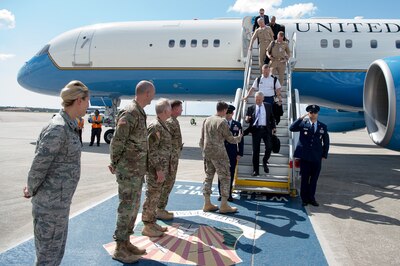By Alun Thomas, U.S. Army Recruiting Battalion-Phoenix
PHOENIX, Oct. 12, 2017 — The wide, beaming smile flashing
across Army Sgt. 1st Class Jaime Guerra’s face was impossible to ignore.
Unfolding before him was an oath of enlistment he had never
expected to see -- that of his own son, Anthony.
Along with his wife, Mayra, and other son, Joshua, Guerra
watched with pride as Anthony was sworn into the Army Sept. 21 by Capt. Eugene
Lee, commander of the Phoenix West Recruiting Company at the Phoenix Military
Entrance Processing Center.
Guerra, a recruiter at the Arrowhead Recruiting Center, said
seeing Anthony join the Army is bittersweet, but as a recruiter and father, he
couldn’t be prouder.
“At the same time my paternal instincts kick in, however, and
I think: ‘This is my boy and I don’t want to see him in danger,”’ Guerra said.
“But I’m extremely proud of him and the path he’s chosen.”
Future Artilleryman
Guerra said Anthony chose the military occupational
specialty of 13B, a cannon crewmember, which didn’t come as a complete shock to
his father.
“When Anthony was younger he didn’t want anything to do with
the Army, because I was always gone, whether in the field or deployed,” Guerra
said. “He would always say: ‘You’re never here. Why would I want to be in the
military?’ But as he got older and we would talk about my experiences in the
Army and in combat, his mindset started changing into a combat arms direction.”
Watching his father’s career progress was certainly an
inspiration for Anthony to join, Guerra said, with his success rubbing off on
his son.
“He’s seen my [17-year] career and how well I’ve done in it
… I think he wants that success as well,” Guerra said. “He wants to be enlisted
and then become an officer, just to surpass me so I’ll have to salute him one
day … but in all seriousness he wants to lead the military life.”
Proud Father
Guerra praised Anthony’s determination, stating once he puts
his mind to something, he always finishes it.
“He told me he wants to do 20 years in the Army and I
believe that’s exactly what he’s going to do -- he’s just that type of person,”
Guerra said.
Guerra said he never pushed Anthony to join the Army, with
the decision being made of his son’s own volition.
“I never bought it up once; especially when I became a
recruiter,” he explained.Guerra said although living the Army lifestyle has
been difficult for Anthony and the rest of his family, with many family moves
and deployments, his son has always coped well with change.
“Right now, Anthony is in his third high school and eleventh
school overall,” Guerra said. “But he’s done really well with all the change.
He’s quiet and thoughtful, which helps see him through.”
Watching Anthony perform the oath of enlistment evoked both
feelings of sadness and pride, he said.
“Watching my little boy up there swearing in made me realize
he isn’t little anymore,” Guerra said. “That’s my son and baby who’s all grown
up and ready to move on with his life.”
For Anthony, 17, performing the oath also gave him an
immense feeling of pride, sharing his father’s feelings.
‘I Felt Proud Reciting the Oath’
“I felt proud reciting the oath. I’m doing something only
one percent of the nation does, so I want to do my part,” Anthony said. “It
felt even better with my dad watching, because he serves as well and I’m
following in his footsteps.”
The chance to serve his country played an important part in
deciding to join, he said.
“I’m making a difference in this world and that’s a good
thing to do. I’ll also get a college education and other benefits thanks to the
Army,” Anthony explained. “I’ve already lived in five states and I’ll get the
chance to see even more of the country and world, too.”
Anthony said he doesn’t ship to Basic Combat Training until
June 2018, which gives him ample time to prepare.
“I’ll use the time to get physically fit and prepare
mentally,” he added. “It’s still nine months away, so I won’t be thinking about
it all the time. But as it gets closer I’ll be nervous and excited to begin.”










